Are you a photographer looking to monetize your passion? Selling stock photos online is a fantastic way to generate income, whether you’re a seasoned professional or just starting out. The internet offers a vast marketplace for your images, connecting you with businesses, designers, and publishers worldwide who are constantly searching for high-quality visuals.
Stock photo websites act as intermediaries, licensing your photos to clients for commercial use. In return, you earn a commission for each sale. This guide dives into the best platforms to sell your stock photos, offering a step-by-step approach to transforming your photography into a profitable venture.
Here are 15 of the top websites where you can sell your photos online, followed by essential tips to help you succeed in the stock photography market.
Best Websites for Selling Photos Online
1. Alamy
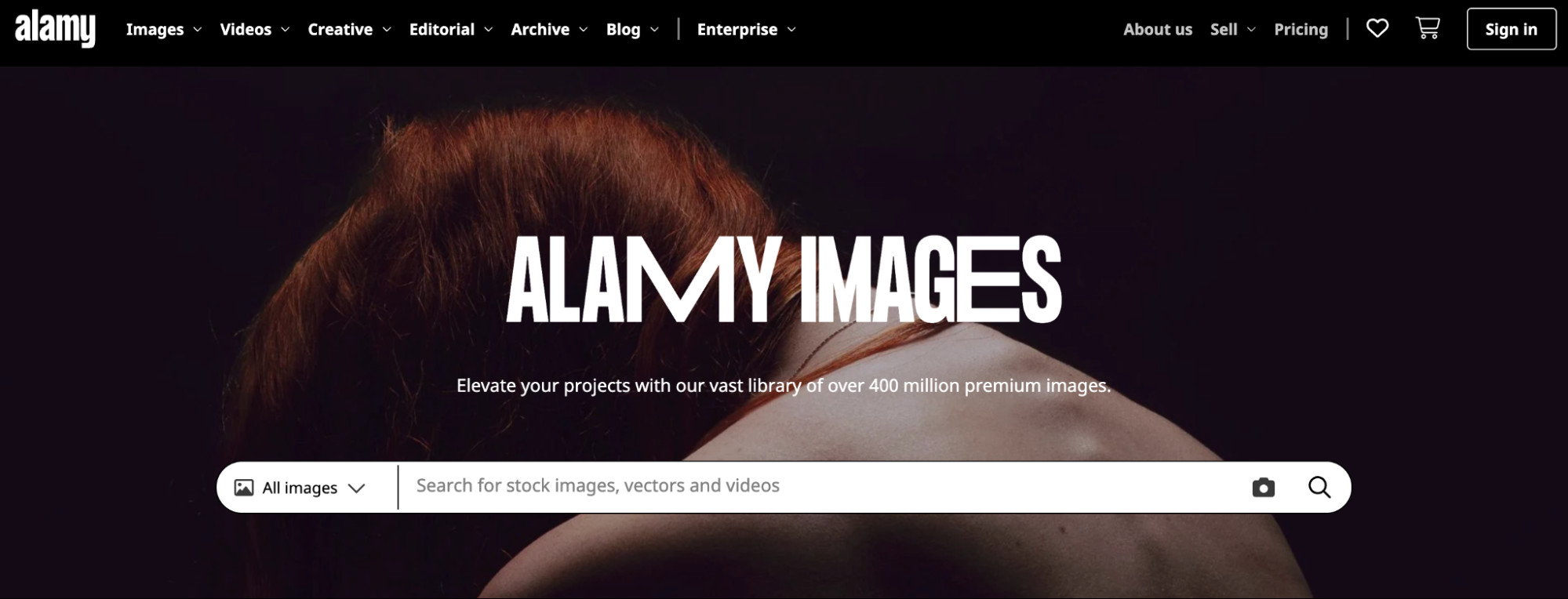 Alamy Images homepage showing a search bar for royalty-free stock images.
Alamy Images homepage showing a search bar for royalty-free stock images.
Alamy boasts one of the most diverse collections of stock photos available online, making it a robust platform for photographers to sell their work. With millions of images, vectors, videos, and even 360-degree panoramic images, Alamy provides numerous avenues for contributors. They also offer Stockimo, an iOS app, allowing you to upload and sell photos directly from your smartphone, further expanding your reach and accessibility.
How to get paid
Alamy provides monthly payments to its contributors with a variety of commission structures. Depending on the image popularity and license type, photographers can earn between 17% and 50% of each sale. Alamy stands out with its flexibility, offering no long-term contracts and payment options in multiple currencies, catering to a global contributor base.
2. 500px
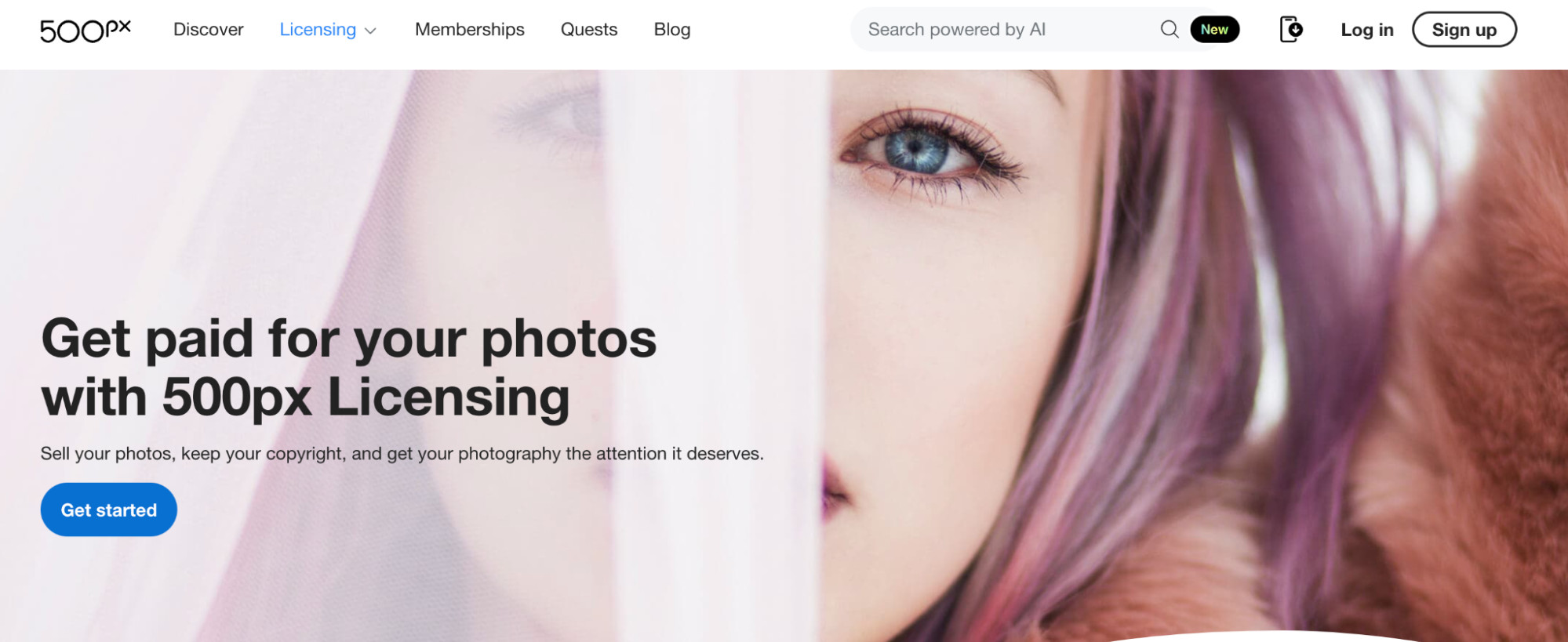 500px’s homepage highlighting licensing options for photographers to earn money.
500px’s homepage highlighting licensing options for photographers to earn money.
500px merges stock photo licensing with a vibrant photographer community. Hosting millions of photographers, 500px provides a platform to both sell and license your photos online. Their unique “Pulse algorithm” is designed to highlight emerging photographers and fresh content to potential buyers, offering a valuable opportunity for photographers who are new to the stock photo market to gain visibility, provided their images meet 500px’s quality standards.
Beyond sales, 500px cultivates an online community for photographers of all levels. You can connect with other creatives, receive constructive criticism on your work, list your photos in their marketplace, and even participate in photo contests for recognition and prizes, enhancing your overall photography journey.
How to get paid
For exclusive photos, paying members on 500px can earn up to an impressive 100% royalty, making it a highly rewarding platform for dedicated contributors.
3. Shutterstock
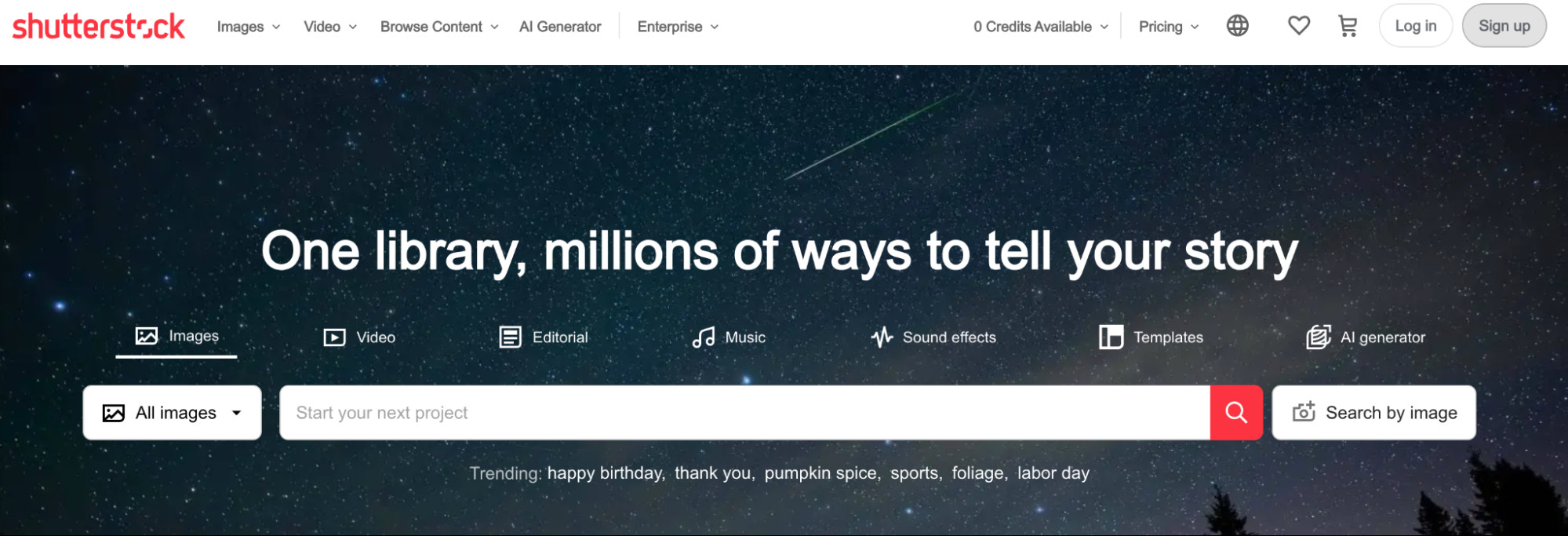 Shutterstock homepage for royalty-free images, videos, and music.
Shutterstock homepage for royalty-free images, videos, and music.
Shutterstock stands as one of the most recognized and widely used stock photography websites globally. As a leading platform for selling photos online, Shutterstock boasts a strong reputation and has paid out over $1 billion to its contributor community in the last 15 years, demonstrating its scale and commitment to photographers.
Shutterstock operates as a micro-stock site, characterized by lower photo prices and non-exclusive licenses. Success on Shutterstock often relies on contributing a large volume of images to increase download potential. While individual image earnings might be lower compared to some platforms, the sheer volume and reach of Shutterstock can make it a valuable starting point, especially for those learning the ropes of selling stock photos.
How to get paid
Shutterstock’s payout structure is based on lifetime earnings, with commission rates ranging from 15% to 40%. They also offer an affiliate program, providing an opportunity to earn additional income by referring new photographers or customers to the platform, creating a potential for diversified earnings.
4. Getty Images
 Getty Images’ homepage with a search bar for high-quality stock photos.
Getty Images’ homepage with a search bar for high-quality stock photos.
Getty Images is renowned for its extensive library of premium stock photos, attracting high-profile brands and online publishers seeking exclusive, high-quality, and often hard-to-find imagery. Together with its microstock subsidiary, iStock (mentioned below), Getty Images reaches over 1.5 million customers globally, highlighting its significant market presence and influence.
Maintaining its premium reputation, Getty Images has stricter standards for photo submissions compared to many other stock photo sites. This selectivity ensures the quality and exclusivity of their collection, catering to clients with discerning needs and higher budgets.
How to get paid
To become a Getty Images contributor, you need to apply with a portfolio of sample photos. Upon acceptance, you can earn between 15% and 45% of an image’s license fee. This commission range reflects the higher value and exclusivity associated with Getty Images content.
5. iStock
 iStock landing page promoting its generative AI image creator.
iStock landing page promoting its generative AI image creator.
iStock is a subsidiary of Getty Images, offering a non-exclusive alternative for contributors. As an offshoot, iStock shares Getty Images’ market reach but distinguishes itself by allowing non-exclusive photo licenses. This means you can sell the same photos on iStock and other platforms simultaneously, providing greater flexibility and potential income streams for photographers.
The key difference between iStock and Getty Images lies in exclusivity. iStock accepts non-exclusive content, making it accessible to a broader range of photographers and image styles, while still benefiting from the established Getty Images network.
How to get paid
Similar to Getty Images, selling photos on iStock requires an application process with sample images. Commission rates on iStock range from 15% to 45%, depending on the specifics of your contributor agreement, reflecting the platform’s tiered structure and options for exclusivity.
6. Stocksy
 Stocksy homepage with artwork of people in a library setting.
Stocksy homepage with artwork of people in a library setting.
Stocksy is known for being an accessible platform, especially beneficial for photographers newer to selling their work online. This stock photography site is popular for its commitment to high payouts for contributors. Stocksy offers a 50% royalty on standard licenses and an even higher 75% royalty on extended licenses, making it one of the more generous platforms in terms of revenue sharing. However, exclusivity is required; all photos sold on Stocksy must be exclusive to their platform.
Stocksy operates as an artist-owned cooperative. This unique structure means contributors are part owners of the business, giving them a voice in its direction. Contributors also benefit from profit-sharing through patronage returns when the cooperative achieves a surplus, aligning the platform’s success with the financial benefits for its photographers.
How to get paid
Stocksy pays its contributors monthly via PayPal, Payoneer, or check, with a minimum payout threshold of $100. For photographers interested in joining, Stocksy provides a comprehensive contributor application FAQ to guide you through the process and requirements.
7. Picfair
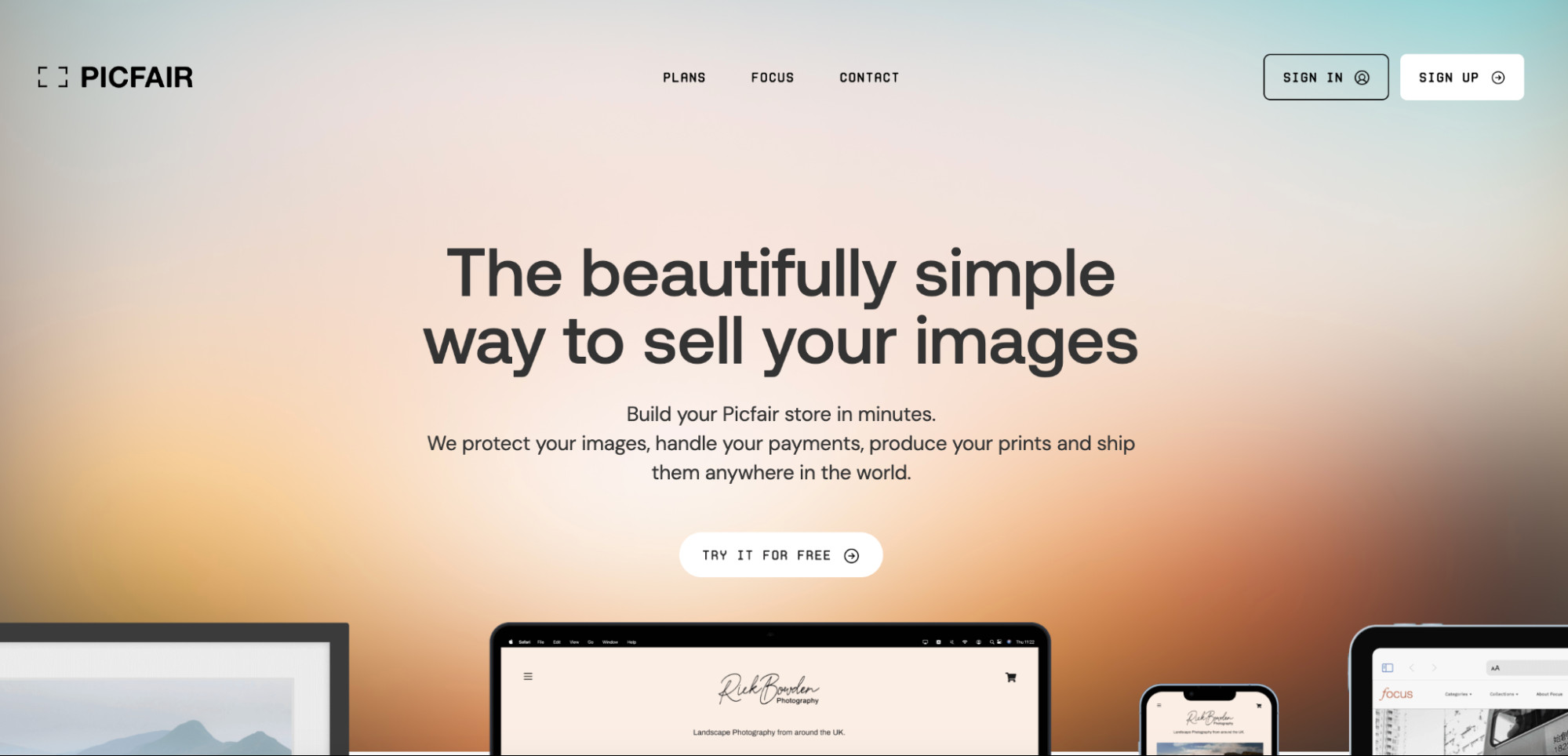 Picfair landing page for a website builder designed for photographers.
Picfair landing page for a website builder designed for photographers.
Picfair offers a unique approach by enabling you to create your own photography ecommerce website, giving you significant control over your online presence and sales. If you desire more autonomy over your online photo portfolio, Picfair is a strong option. You have the freedom to set your own prices for both prints and digital downloads, and Picfair handles the complexities of payment processing. They also manage print production, shipping logistics, and licensing for digital images, simplifying the selling process for photographers.
How to get paid
To utilize Picfair’s full features, you need to sign up for their Plus plan, priced at $5 per month when billed annually. This plan allows you to create a customized Picfair store with the capacity to host up to 10,000 images, which can be offered as prints or digital downloads, providing a comprehensive platform for selling your photography directly.
8. Adobe Stock
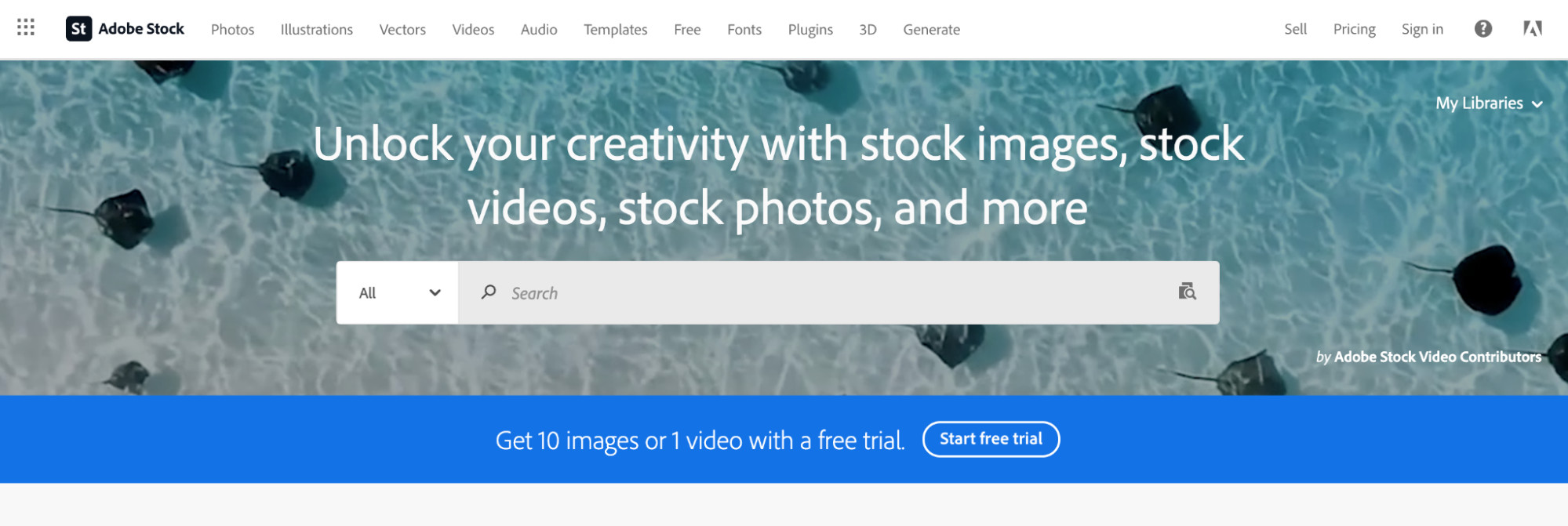 Adobe Stock homepage showcasing a search bar over an underwater stingray photo.
Adobe Stock homepage showcasing a search bar over an underwater stingray photo.
Adobe Stock seamlessly integrates with Adobe’s widely used suite of photography software, making it a convenient platform for photographers already within the Adobe ecosystem. If you’re a regular user of Adobe Creative Suite for your photography projects, Adobe Stock provides a natural extension to monetize your images, videos, vectors, and illustrations directly through their online stock photo platform.
How to get paid
Adobe Stock offers a streamlined workflow by allowing you to upload your assets directly from Lightroom and Bridge once your editing process is complete. Contributors who link their Adobe ID to Adobe Stock can earn a 33% royalty on photo sales and 35% on video sales, offering a competitive commission structure within a familiar and integrated environment.
9. Envato Elements
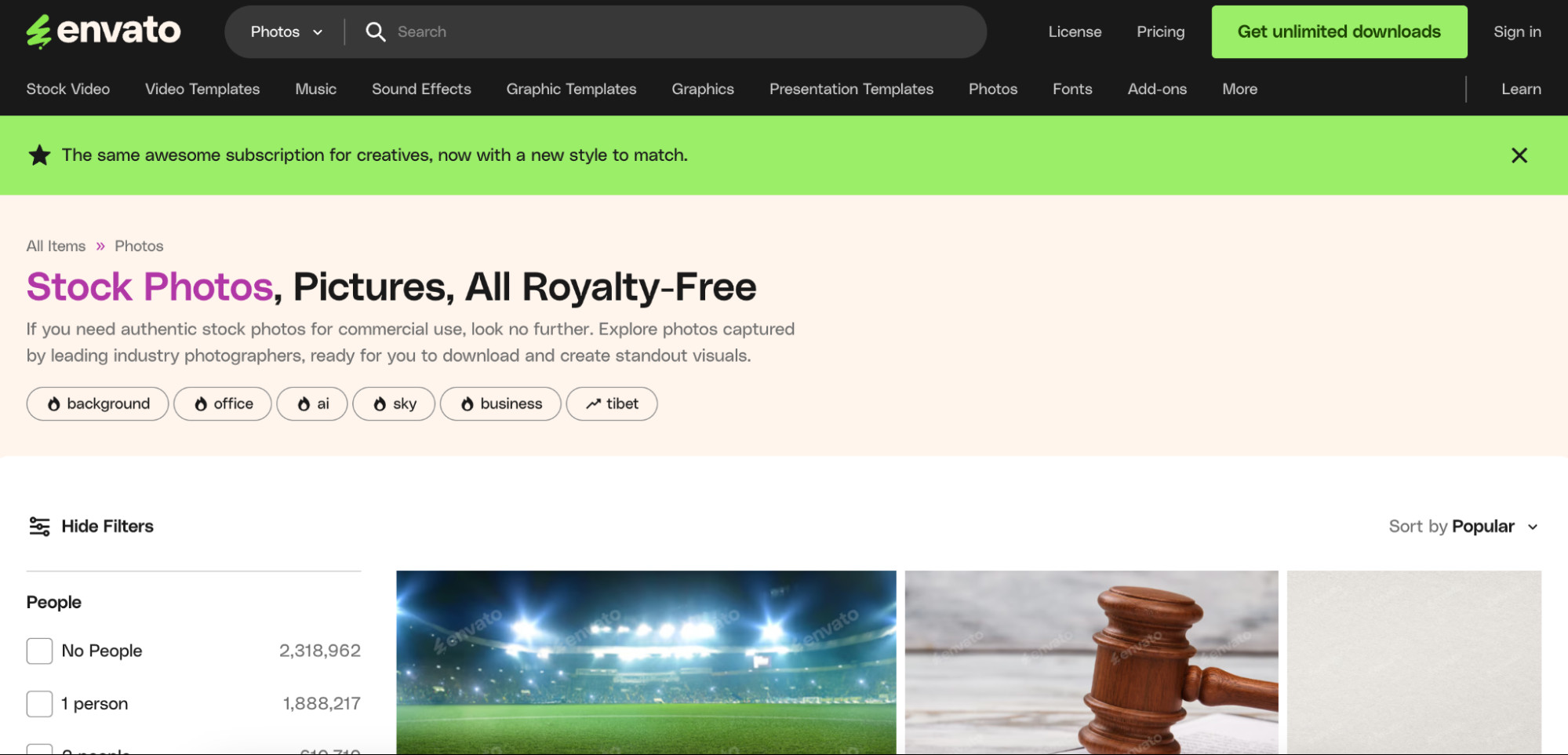 Landing page for stock photos on Envato Market.
Landing page for stock photos on Envato Market.
Envato Elements provides an opportunity to earn a share of the total subscriber revenue, offering a different income model compared to traditional stock photo platforms. As a stock photography site, Envato Elements allows you to sell your photos online and connect with a broad base of potential clients, tapping into Envato’s extensive user network.
Envato Elements gives you flexibility in how you sell your photos. You can sell directly through their platform or integrate and display your photos on your own website using Envato’s domain, providing options to suit different preferences and marketing strategies. It’s a popular avenue for photographers to sell pictures and generate income from their creative work.
How to get paid
Contributors to Envato Elements earn between 25% and 50% of the net subscription revenue. This revenue-sharing model means your earnings are tied to the overall performance of the Envato Elements subscription service, offering potential for growth as the platform’s subscriber base expands.
10. Unsplash+
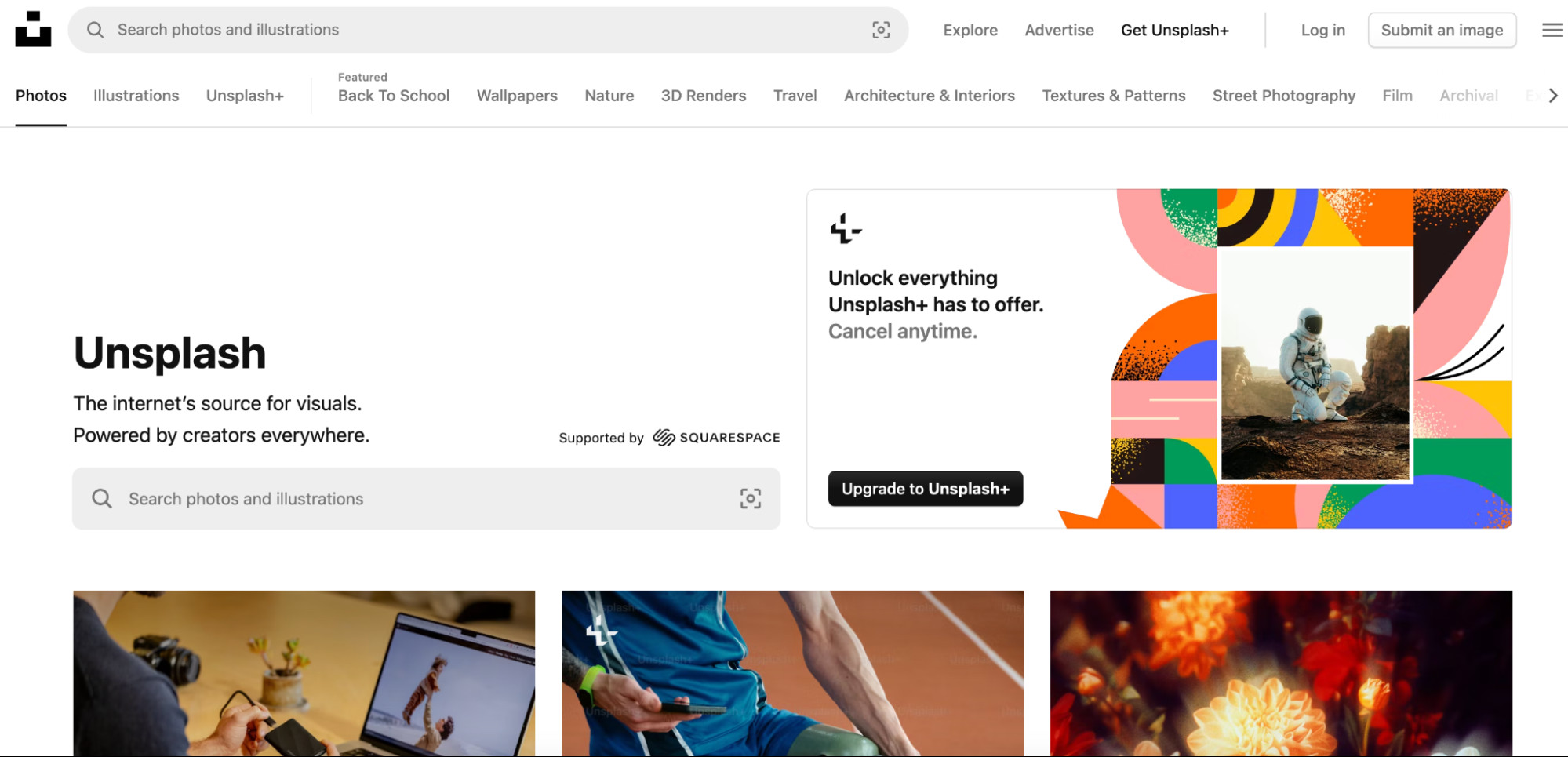 Unsplash homepage featuring stock photos and a Unsplash call-to-action.
Unsplash homepage featuring stock photos and a Unsplash call-to-action.
Unsplash+ operates on a unique model where photographers are paid for submitting images that fulfill specific assignments, moving away from direct sales-based commissions. While Unsplash is known as a free stock photo site (also owned by Getty Images), Unsplash+ represents their premium, paid contributor program. Instead of earning royalties per photo download, Unsplash+ partners with photographers through assignments and briefs created based on customer needs.
How to get paid
To become an Unsplash+ contributor, you need to complete their contribution application and gain acceptance into the program. Once approved, you gain access to a list of briefs outlining specific image requests from Unsplash customers. You can then choose briefs that align with your photography style and skills, submit your photos, and get paid for each image that is accepted. Payment rates for accepted photos typically range from $5 to $30 per image, offering a project-based income opportunity.
11. Dreamstime
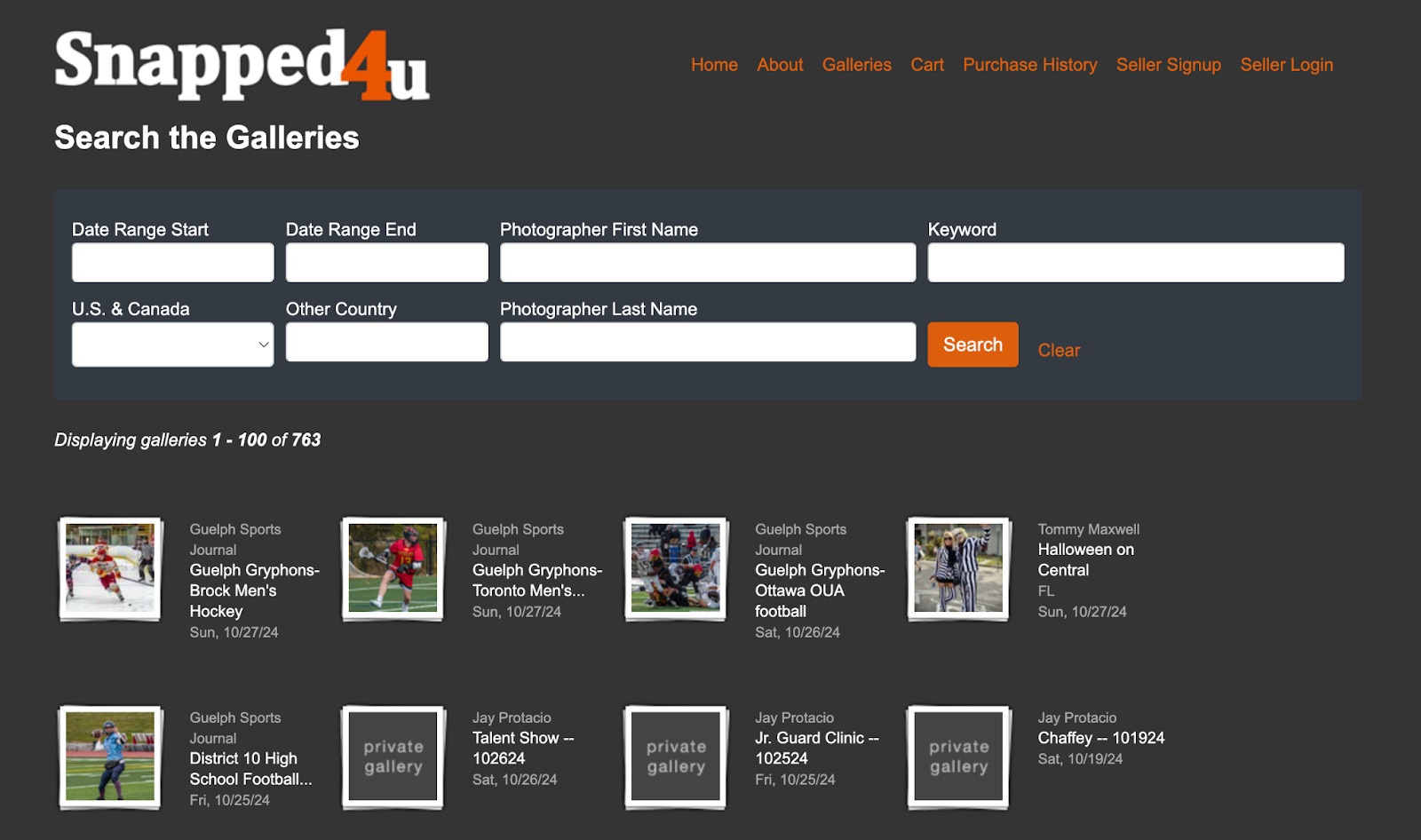 Dreamstime homepage displaying photos from various categories.
Dreamstime homepage displaying photos from various categories.
Dreamstime’s extensive microstock library contains over 250 million photos, making it a large-scale platform for photographers to reach a wide audience. As a microstock platform, Dreamstime offers a vast collection of royalty-free media, including not only stock photos but also vectors, videos, and audio files. With such a massive library and a user base exceeding 50 million, Dreamstime provides photographers with access to a significant and active market for their work.
How to get paid
Dreamstime offers a revenue-sharing model ranging from 25% to 50% for non-exclusive content. Contributors who choose to make their content exclusive to Dreamstime can earn an additional 10% commission and receive a bonus of 20¢ for each approved submission. Dreamstime also features an affiliate program, allowing you to earn 10% of transaction values for each new contributor or customer you refer to the platform, creating additional earning avenues.
12. Snapped4U
 Dreamstime homepage displaying photos from various categories.
Dreamstime homepage displaying photos from various categories.
Snapped4U specializes as a photo marketplace tailored for event and portrait photographers, carving out a niche within the stock photography landscape. This platform is specifically designed for photographers who focus on capturing portraits and event photography. Snapped4U allows photographers to create personalized online galleries, set their own pricing (up to $20 per image), and directly sell digital files to their clients, offering a more direct sales approach.
Snapped4U is particularly suited for photographers selling photos to individuals who attended specific events or portrait sessions. The platform is not intended for general stock photography like travel, landscape, or still-life images, focusing instead on event-specific and personal photography sales.
How to get paid
Snapped4U has a straightforward fee structure. They charge a one-time $10 registration fee when you sign up. After registration, Snapped4U retains a commission ranging from 10% to 12% on your sales. Photographers are paid their account balance via PayPal on the 1st and 15th of each month, providing regular payment intervals.
13. Foap
 Foap creator landing page for photographers mobile app.
Foap creator landing page for photographers mobile app.
Foap distinguishes itself by enabling photographers to sell their images directly to brands and agencies, fostering a more direct brand-photographer connection. This photo-selling site facilitates the sale of commercial-quality images directly to businesses and individuals. Foap also offers “missions,” where brands post specific photo or video briefs, and photographers can submit content to fulfill these needs, with rewards for the selected winners. To date, Foap has paid out over $3 million to its community of creators, demonstrating its success in connecting photographers with brands.
How to get paid
Payouts for Foap “missions” can range significantly, from $100 up to $2,000, depending on the mission’s scope and brand requirements. Photographers can also sell individual photos on the general Foap market. Foap takes a 50% commission on all sales, whether through missions or the marketplace, maintaining a consistent revenue share model.
14. EyeEm
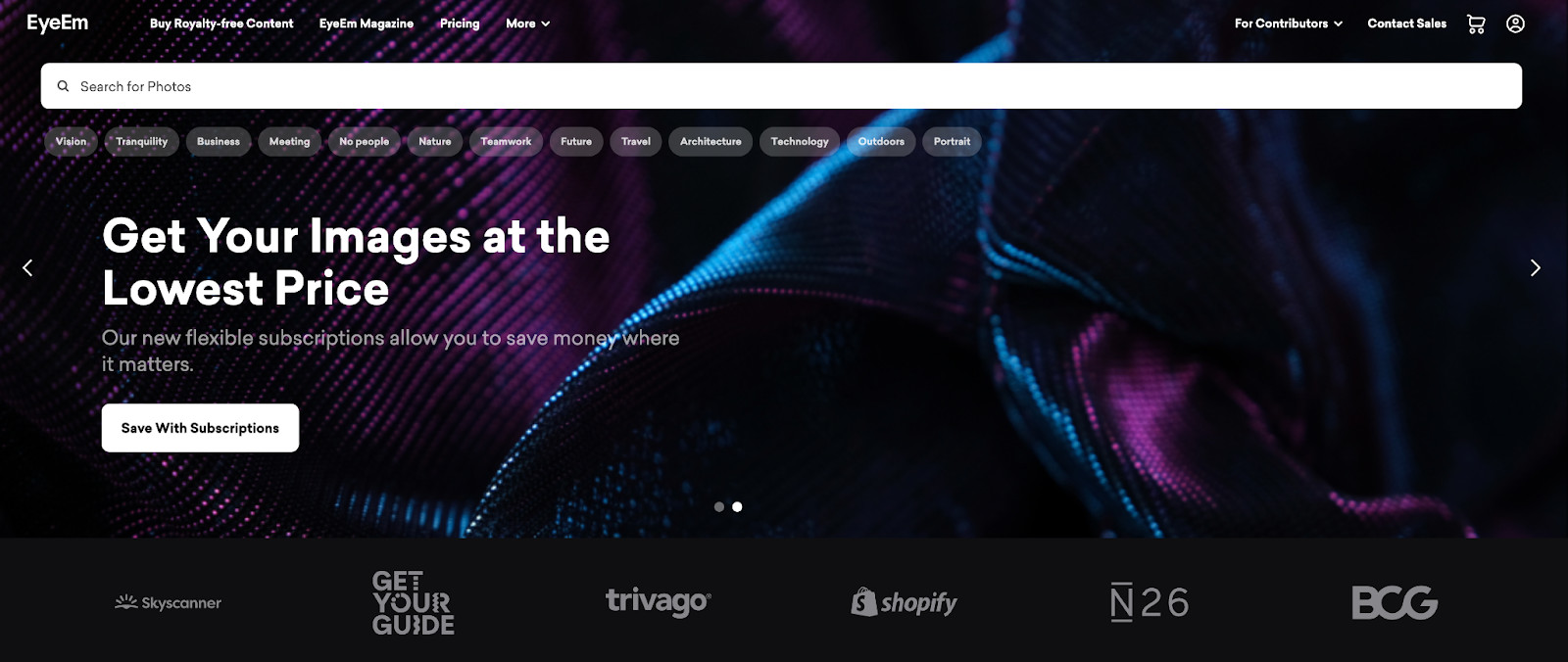 EyeEm homepage with search bar and client examples.
EyeEm homepage with search bar and client examples.
EyeEm blends a photographer community with a stock photo marketplace, creating a platform focused on both selling and networking. EyeEm combines the functionality of a marketplace for licensing photos with the engagement of a photographer community. The platform encourages photographers to participate in “missions” which are themed calls for images, providing creative direction and opportunities to get noticed.
How to get paid
Contributors to EyeEm earn a 50% commission on each photo sale made through the EyeEm marketplace. Payments to photographers are processed via PayPal, offering a standard and widely accessible payment method.
15. Pond5 (for videos)
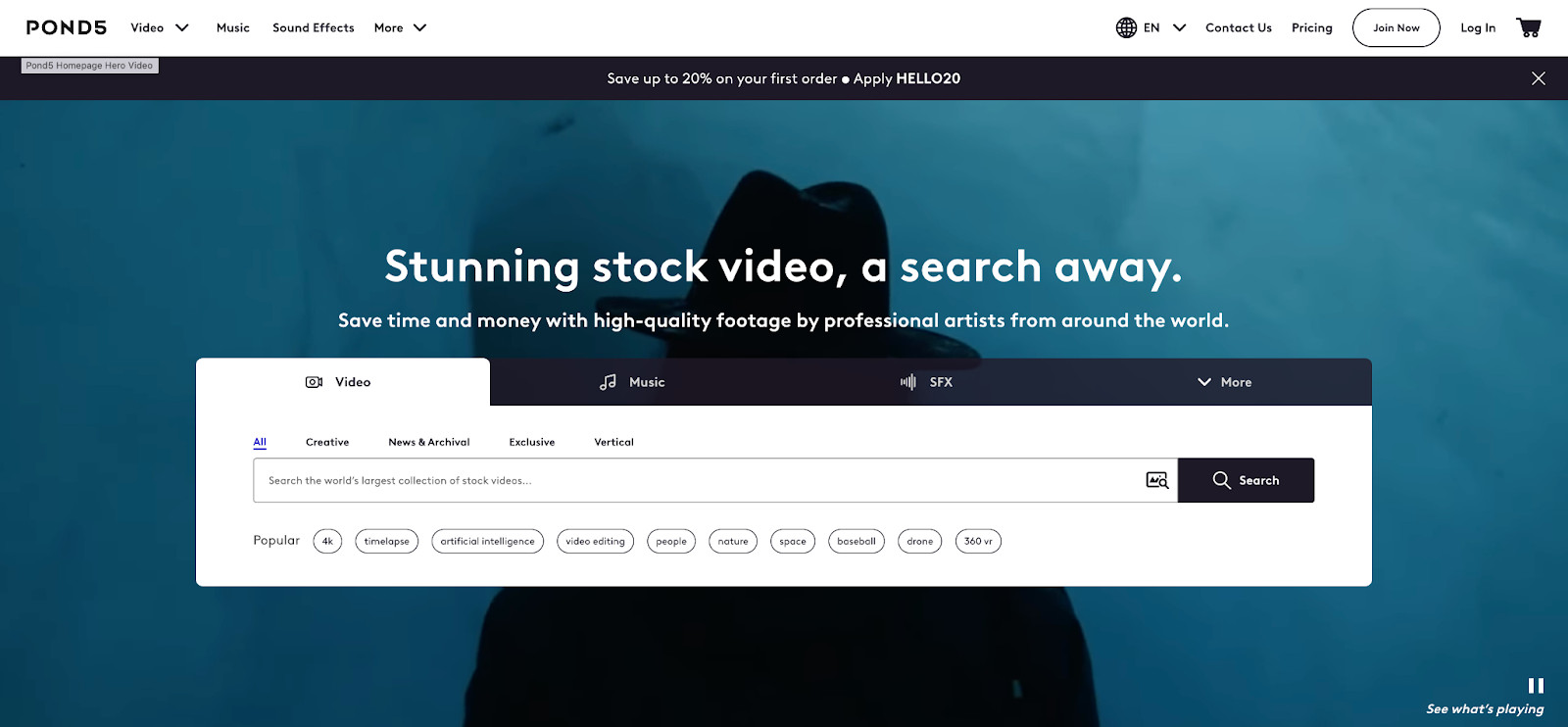 Pond5 homepage for stock video and media assets.
Pond5 homepage for stock video and media assets.
Pond5 specializes in video content, serving as a marketplace frequented by major brands and clients specifically seeking video and multimedia assets. Unlike the predominantly photo-focused sites listed above, Pond5 is a marketplace dedicated to selling royalty-free videos, as well as music, sound effects, and other media assets. According to Pond5, their customer base of over one million includes major clients like the BBC and Disney, with contributor content used in diverse projects from advertisements to TV shows and feature films. Contributors on Pond5 create storefronts to showcase their media portfolios.
How to get paid
Video artists on Pond5 start with a 40% royalty share. There is an option to increase earnings up to 60% by making your content exclusive to the platform. Pond5 also facilitates direct connections with clients through their Artist Portal, where contributors can respond to specific client briefs and requests. Additionally, Pond5 offers a referral program, providing artists with opportunities to earn extra income by bringing new contributors or clients to the platform.
Tips for Selling Photos Online
To build a successful stock photo business, consider these key strategies:
Define Your Stock Photography Niche
Many successful stock photographers develop a distinct style or focus that permeates their work. Whether your passion lies in travel, fashion, nature, or food photography, consistency is a valuable asset.
Often, photographers discover their niche through experimentation, identifying subjects and styles they enjoy shooting that also resonate with a target audience. To gauge market demand for specific themes, keyword research is invaluable. Tools like Google Trends can help you analyze the popularity of image topics, revealing trends and opportunities within the stock photo market.
Get on Instagram
Similar to bloggers and YouTubers, photographers looking to sell images online should prioritize building an engaged audience.
Visual social media platforms like Instagram are powerful tools for reaching a broad audience. Utilizing Instagram tools can help you identify and connect with relevant accounts, engage with trending hashtags, and cultivate a following of potential customers and clients.
Linking your social media accounts streamlines your photo sharing across platforms and amplifies your visibility. For example, Instagram allows you to link your accounts to simultaneously post images on Facebook, maximizing your reach and efficiency.
Integrate Ecommerce into Your Website
Most photographers maintain a personal website to showcase their portfolio to prospective clients. By integrating a Shopify Buy Button into your site, you can seamlessly enable customers to purchase stock images directly from you.
Photographer Dave Sandford, for example, uses his website to not only display his stunning wildlife photography but also to sell prints and calendars directly to his audience.
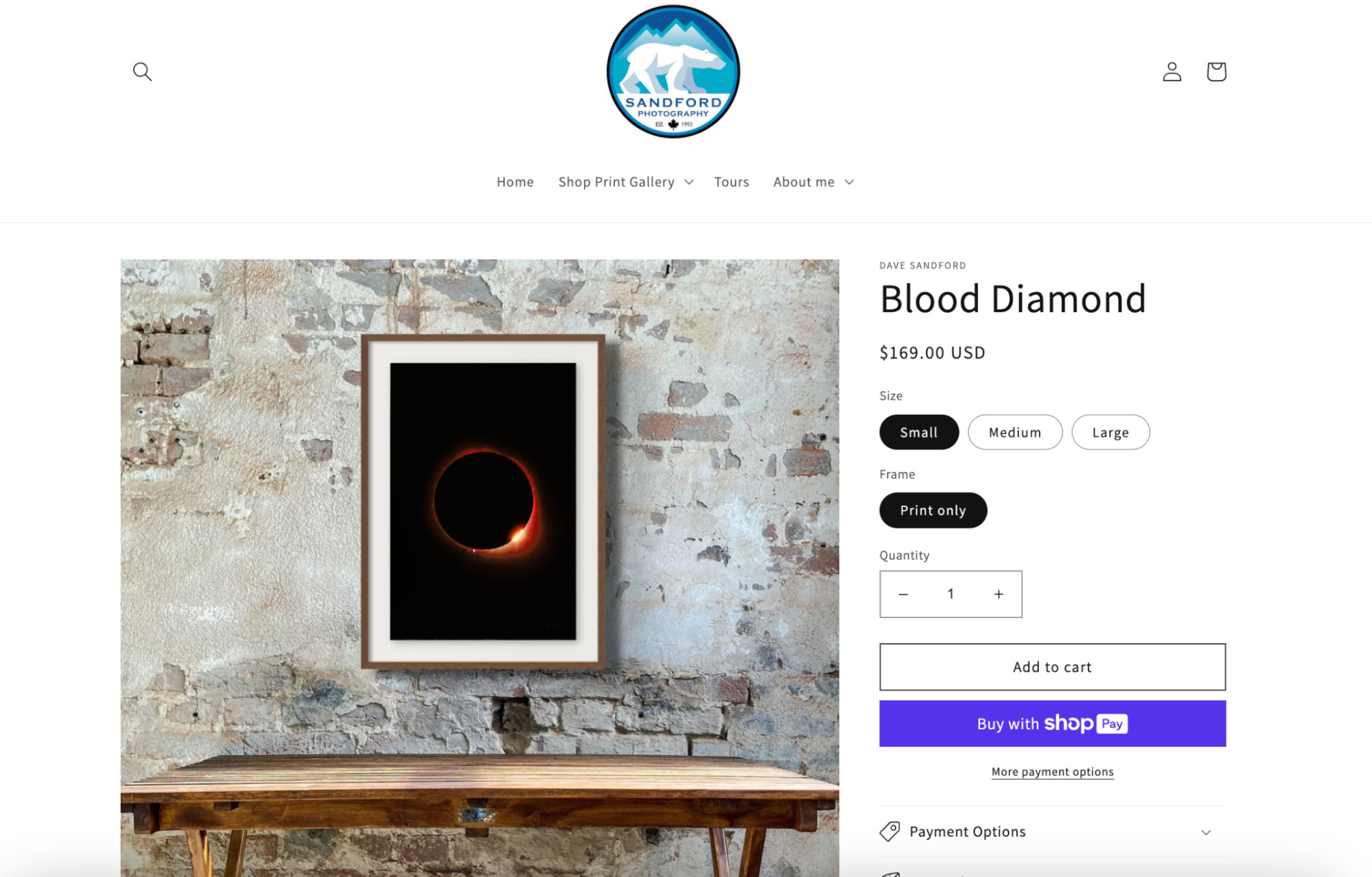 Product page example from an ecommerce photography website.
Product page example from an ecommerce photography website.
Creating a personalized portfolio page or online store on a platform like Shopify is often the most straightforward way to sell photos online, giving you control over your brand and customer experience.
Utilize pre-designed themes specifically for art and photography to quickly set up your digital showroom, or combine a free theme with a gallery app to create a visually appealing and functional online store.
Understand Your Market
Your target market comprises the individuals or businesses most likely to purchase your photos. Understanding who they are, their interests, and their needs is crucial for producing commercially viable stock photos.
For instance, if you specialize in wedding photography, the primary buyers of your stock images aren’t necessarily couples planning their weddings. Instead, they are more likely to be businesses within the wedding industry, such as stationery brands or suit wholesalers, who need royalty-free images of wedding celebrations for their marketing materials.
By identifying your buyer persona, you can tailor your photography to meet their specific needs, upload images to the platforms where they search for content, and price your photos competitively within their budget.
How to Set Up Your Online Portfolio
Follow these steps to create an effective online photography portfolio:
1. Choose the Right Platform
There’s no single “best” platform for monetizing your photos; the ideal choice depends on your photography business goals and the level of control you desire over your imagery.
Here’s a quick overview of platform options:
- For Hobbyists or Passive Income: Stock photo submission sites like iStock or Alamy are ideal for casual contributors or those seeking supplemental income.
- For Brand Assignments: Unsplash+ is suited if you prefer working on briefs and receiving assignments without active pitching.
- For Full Business Control: Ecommerce platforms like Shopify offer complete control for building and managing a comprehensive photography business.
2. Plan Your Portfolio’s Structure
Your portfolio serves as your photographer’s resume, showcasing your best work to potential clients and buyers.
Focus on these portfolio elements:
- Layout: While photos should be the focal point, adding context with brief image descriptions can enhance user engagement and improve search engine optimization for your portfolio.
- Social Proof: Incorporate social proof to demonstrate the popularity and impact of your work. Include testimonials from satisfied clients or showcase instances where your images have been used in successful campaigns.
- Categories and Organization: Make it easy for visitors to browse your images by implementing clear categories and tags. For example, nature photographers could organize collections by location, environment, subject, or date.
- Gallery Size: Curate your online portfolio to only include your highest quality images. Remove any photos you are not fully satisfied with to ensure your portfolio showcases your best work and maximizes impact.
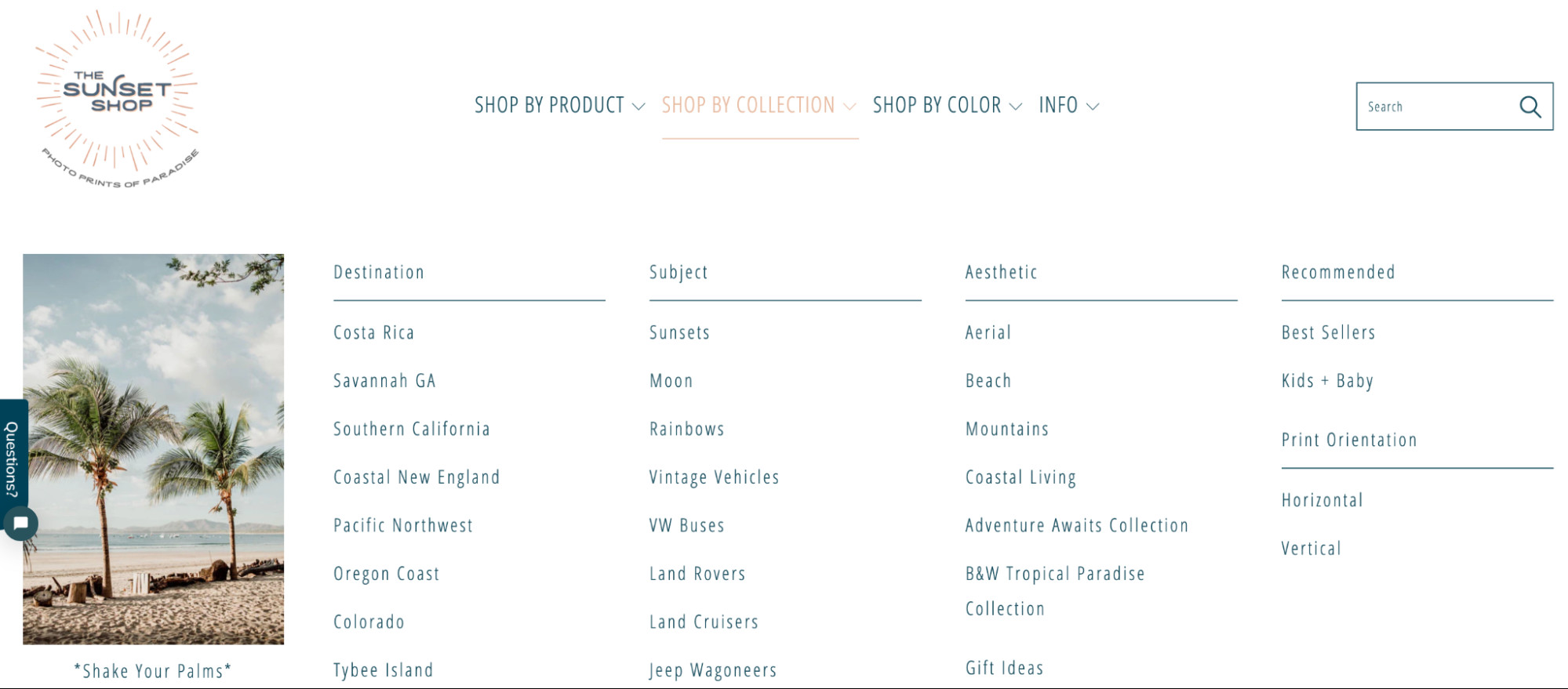 Example product categories for a photo print website.
Example product categories for a photo print website.
Websites like The Sunset Shop effectively use categories based on photo type, aesthetic, and location to enhance browsing and user experience.
3. Optimize Images for the Web
While photographers strive for high-resolution images, optimizing them for web use is crucial for user experience. Fast-loading images are essential, as large image files can significantly slow down page load times, leading to visitor frustration and abandonment.
When uploading images to your online portfolio:
- Compress Image Sizes: Reduce file sizes as much as possible without compromising visual quality. Aim to compress images between 60% and 80% of their original size.
- Use Descriptive File Names: Instead of generic names like “IMG_3542.jpg,” use descriptive filenames such as “summer-evening-nature.jpg” for better SEO and organization.
- Write Alt Text: Add descriptive alt text to each image. This text helps search engines understand the content of the image and improves accessibility for users with screen readers.
4. Create an About Page
People connect with stories and personalities. An About page provides an opportunity to introduce yourself and build rapport with potential customers. Share your photography journey, your passion, and what makes your work unique.
Use your About page to create a compelling personal brand. Discuss how you entered photography, your favorite subjects to shoot, and your sources of inspiration. Authenticity and passion can be powerful selling points.
5. Implement Ecommerce Functionality
An ecommerce platform streamlines the complexities of selling photos online, handling crucial aspects like transactions, inventory, and customer management. Using a platform like Shopify provides features to:
- Build a fully functional online storefront for self-service purchasing.
- Integrate with social media storefronts like Instagram Shop for expanded sales channels.
- Securely process payments and manage sales tax calculations.
- Facilitate both digital and physical product delivery to customers.
- Manage and track marketing campaigns to promote your photos.
 Product page example for a printed photo on an ecommerce site.
Product page example for a printed photo on an ecommerce site.
Websites like The Bee & The Fox utilize Shopify to effectively sell photography prints online, demonstrating the platform’s versatility for photographers.
6. Ensure Mobile Compatibility
With the majority of website traffic originating from mobile devices, mobile compatibility is no longer optional. Ensure your online portfolio is fully responsive and provides a seamless experience on smaller screens.
A mobile-friendly website uses responsive design to adapt to different screen sizes, displays photos effectively in vertical orientations, and utilizes large, finger-friendly buttons for easy navigation.
7. Launch and Promote Your Photos
Once your portfolio is ready, it’s time to promote your work and drive traffic to your site. Utilize marketing tactics such as:
- Social Media Reposting: Regularly share your images on social media platforms to maintain visibility and engagement.
- Pinterest Marketing: Pin your photos on Pinterest and link them back to your portfolio site to tap into Pinterest’s visual search engine.
- Influencer Outreach: Gift free prints or digital images to relevant influencers in exchange for promotion or features.
- Behind-the-Scenes Content: Create engaging behind-the-scenes content on platforms like TikTok, YouTube, or Instagram Reels to showcase your process and personality.
- Email List Building: Offer website visitors a discount code or freebie in exchange for signing up for your email list to build a direct marketing channel.
How to Sell Photos as Prints and Photo Books
Expand your revenue streams by offering physical products featuring your photography. Selling prints, photo books, and merchandise can create new income opportunities.
Selling physical products can be more straightforward than you might think. You can sell photos as prints on various materials or incorporate your images into products like mugs, t-shirts, and calendars. Popular platforms and services include print-on-demand companies that handle production and shipping.
Working with a local photo lab can provide personalized service and quality control for prints, while print-on-demand services offer a wider range of product options and dropshipping capabilities.
Always order samples to personally assess the product quality and ensure it aligns with the high standards of your photography.
How to Sell Photography Online as Photo Books
Photo books are another valuable physical product to showcase and sell your photography, particularly for niche or thematic collections. A cohesive and compelling theme enhances the appeal of your photo books.
Print-on-demand services offer a low-risk way to test the market demand for your photo books before investing in large print runs. While margins might be lower with POD, it eliminates upfront costs and storage concerns.
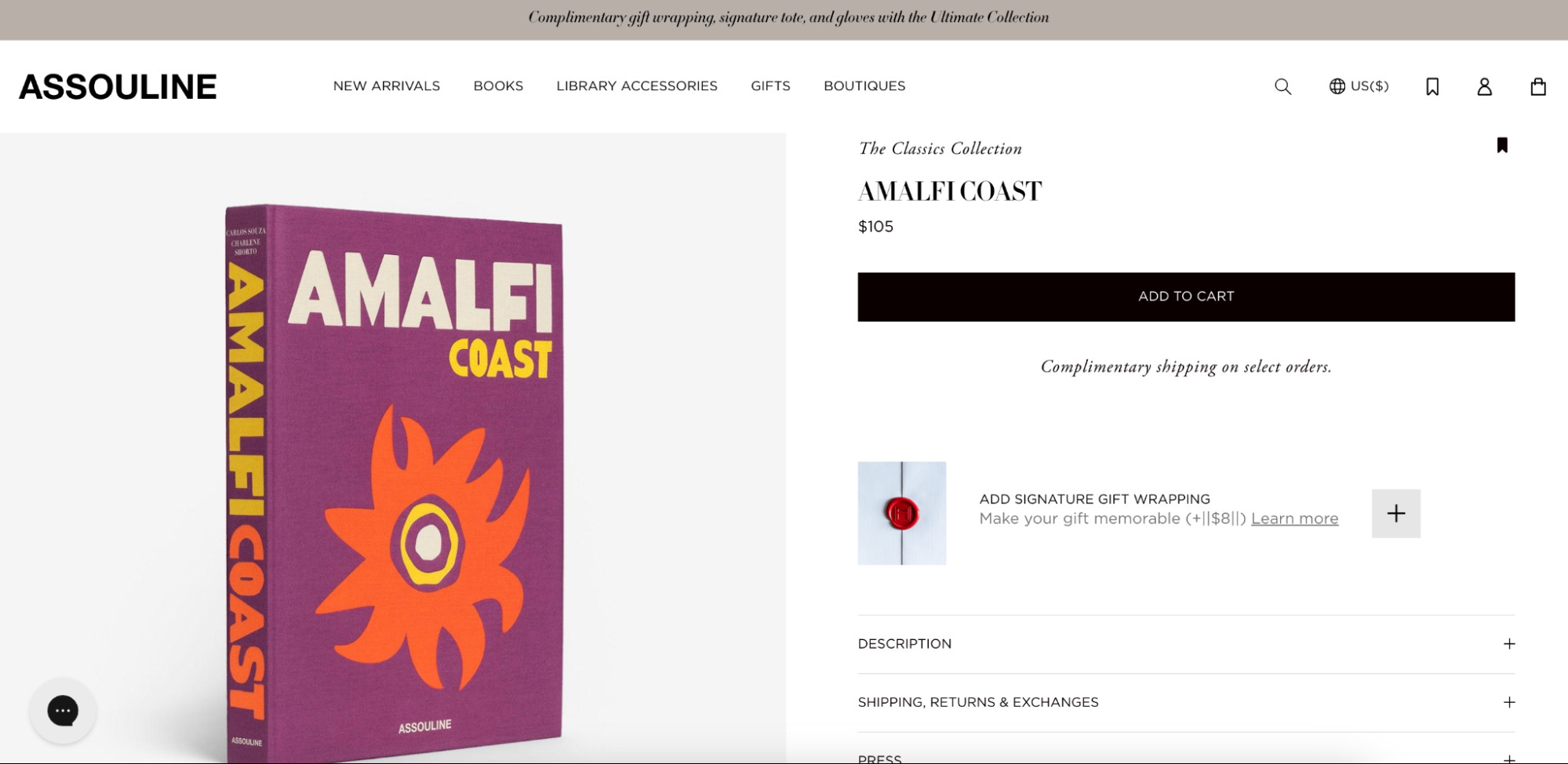 Photobook example featuring images from the Amalfi Coast.
Photobook example featuring images from the Amalfi Coast.
Publishers like Assouline specialize in premium photo books showcasing images from popular travel destinations, demonstrating the market for high-quality, thematic photo books.
How to Sell Your Photography Services
Beyond stock photography, offering your photography services directly opens up further business avenues. Whether you specialize in event coverage, fashion shoots, or product photography, numerous opportunities exist for professional photographers.
Freelance directories like Fiverr and Upwork can connect you with clients seeking photography services. Additionally, local networking and video conferencing can expand your client reach.
Networking tips for selling photography services:
- Business Cards: Always carry business cards. Use online business card generators to create professional cards.
- LinkedIn Optimization: Optimize your LinkedIn profile to showcase your work and highlight your primary photography service specialization.
- Networking Events: Attend industry events where entrepreneurs and event organizers are present, as they are often in need of photography services.
- Personal Brand Building: Regularly share your work on social media to stay top-of-mind within your network when photography needs arise.
For service-based photography, a booking platform is essential for managing schedules and client appointments. Platforms like Setmore and SimplyBook.me offer free plans suitable for photographers. If using Shopify, consider adding a scheduling app to enable direct bookings through your website.
Pricing Strategy for Selling Photos Online
Your skill and dedication are key determinants of your earning potential in stock photography. Developing a strategic pricing approach is essential for maximizing your income.
Here’s a guide to pricing your photography:
- Market Research: Research competitor pricing and survey your target market to understand their price expectations for comparable photos.
- Profit Margins: Calculate your photography expenses, including equipment, website costs, and marketing, to ensure your pricing covers these costs and generates profit.
- Usage-Based Pricing: Differentiate pricing based on usage rights. Exclusive licenses command higher prices than non-exclusive ones.
- Discounts and Promotions: Utilize discounts and promotions to incentivize purchases, whether for new customers or to reward loyal clients.
- Product Bundles: Offer bundled image collections at discounted prices to increase sales volume. For example, sell a themed set of images at a price lower than purchasing each image individually.
Legal Primer for Selling Your Photos Online
Understanding the legal aspects of selling photography is crucial for protecting your rights and ensuring compliance. While this is not legal advice, these definitions provide a foundation for navigating usage rights:
Glossary of Legal Terms for Selling Photos Online
- Editorial Use: Permission to use photos in news, blogs, magazines, and similar publications.
- Commercial Use: Permission for marketing and advertising to promote products or services.
- Retail Use: Permission to incorporate photos into physical products for sale (prints, merchandise).
- Exclusive Use: The licensee is the only entity permitted to use the photo.
- Non-Exclusive Use: Multiple licenses can be sold for the same photo.
- Public Domain: Photos without copyright restrictions, free for any use.
- Creative Commons: Conditional usage allowed based on specified restrictions, often requiring attribution.
- Royalty Free: Licensees can use the photo unlimited times for a one-time fee.
- Rights Managed: One-time license with usage restrictions; additional licenses required for further use.
- Right of Publicity: Subjects in photos have rights regarding their image, especially for commercial use. Seek explicit permission from subjects for commercial stock photos.
What to Do If Someone Steals Your Photos
Photo theft is unfortunately common. Watermarking your digital images before online sharing can deter unauthorized use. Use watermarking tools in Photoshop or online watermark generators to apply identifying marks.
If you discover your photos are being used without permission, a cease and desist request is often effective. Alternatively, you can send an invoice for unauthorized usage. Combining both actions usually yields the best results, offering the infringer the option to pay or remove the image.
Always aim to receive credit for your work, even for editorial uses. Backlinks to your portfolio website are valuable for driving traffic and improving your search engine ranking.
From beginners to established professionals, platforms like Shopify provide tools and resources for everyone to succeed in selling photos online.
Read More
How to Sell Photos Online FAQ
What is the best way to sell photographs?
Selling photographs as stock images on third-party websites like iStock, Shutterstock, or Alamy is often the most efficient way to start. Stock sites offer ease of use, wide market reach, and handle the sales process.
Where can I sell my photos online for money?
Here are some top platforms to sell your photos online and earn money:
- Alamy
- 500px
- Shutterstock
- Getty Images
- iStock
- Stocksy
- Picfair
- Adobe Stock
- Envato Elements
- Unsplash
How do you make money from stock photography?
Stock photography websites act as agencies, selling licenses for images that you upload. The agency licenses individual images to clients at a set price, and you, as the photographer, receive a royalty payment for each license sold.

